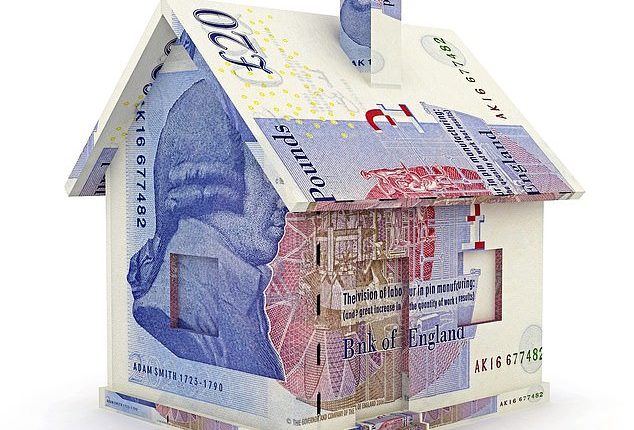
There is finally light at the end of the tunnel for beleaguered homeowners, as a dramatic drop in inflation announced last week could spell the end of mortgage rate misery.
Annual inflation fell to 4.6 per cent in October from 6.7 per cent in September, surprising investors and the Bank of England.
Over the past year, the Bank’s bid to harness soaring inflation with an aggressive series of interest rate rises has driven mortgages to sky-high rates. This has added thousands of pounds to the average homeowner’s annual mortgage costs, with millions refixing facing a shock.
Some 7.5 million households are expected to have been affected by the rate rises. But with inflation slowing, have we seen the worst of high rates and could mortgage costs fall back? We investigate.


Light at the end of the tunnel: With inflation slowing, have we seen the worst of high rates and could mortgage costs fall back?
Mortgage rates to fall below 4%
The drop in inflation could mark a watershed in the battle against the spiralling cost of living, which saw inflation peak at 11.1 per cent last autumn. With inflation forecast to continue to fall this removes the main reason driving the Bank of England’s base rate hikes.
The base rate could be cut as soon as May and fall to 4.25 per cent by the end of next year, analysts at Morgan Stanley forecast.
Earlier this month, the Bank of England’s chief economist Huw Pill had predicted the first cut would be in August. The Bank ended its run of rises in September, holding rates at 5.25 per cent.
Lenders reacted to last week’s news with a flurry of cuts. Banks have reduced mortgage rates over the past two months, but the pace has increased in recent days.
On Thursday, Barclays reduced the cost of its two-year fixed-rate deals for homeowners by 0.3 of a percentage point.
Homeowners with a 40 per cent stake in their property can now secure a two-year deal at 4.98 per cent with a £999 fee.
On Tuesday, First Direct cut its rates by up to 0.4 of a percentage point. HSBC announced cuts of up to 0.35 of a percentage point on residential and buy-to-let mortgages on Wednesday.
Jamie Lennox, at broker Dimora Mortgages, says five-year fixed-term mortgage rates of less than 4 per cent could come before Christmas even, adding: ‘It’s not far off. If a big lender makes the move others will follow.’
> Best mortgage rates calculator: Check deals based on your home’s value
How a five-year fix at 4% could save £12,500
David Hollingworth, broker at L&C, says: ‘We’re already seeing some cuts and that will carry on to the end of the year and into next.’
He expects five-year fixed-rate mortgages to hit 4.5 per cent in the coming weeks, a huge relief to homeowners.
Someone on a five-year deal would pay £12,534 less fixing at 4 per cent instead of this year’s high of 6.37 per cent. This assumes a mortgage balance of £150,000 paid over 25 years.
But homeowners coming off a fixed rate deal agreed a few years ago will still be in for a shock when they remortgage, as rates remain far higher than in recent years and are likely to stay elevated.
Lennox wants to see an improvement in remortgage deals as existing homeowners tend to fare worse than prospective buyers. He says rates on remortgage applications are still typically 0.2 to 0.3 of a percentage point higher than for first-time buyers.
Those looking to change lender also face more stringent affordability checks, which could force them to stick with their existing lender.
He also warns that lenders might raise their product fee if rates fall. These are around £999, but Lennox says £2,000 could be more common as rates continue to plummet.
Respite at last for landlords
Falling inflation offers new hope for landlords considering selling their buy-to-let investments to leave the market. In 2022, landlords sold more than 200,000 properties as they battled a tidal wave of high mortgage costs, higher taxes and uncertainty around new legislation.
Andrew Montlake, at Coreco Mortgages, says: ‘Buy-to-let will get some respite. It will make it easier for landlords to meet affordability levels.’
Buy-to-let mortgages attract higher interest rates and require larger deposits than residential mortgages. The average two-year fixed-rate buy-to-let deal peaked at 6.97 per cent in July, according to rates analyst MoneyfactsCompare.
Should you hold out for a lower rate?
With fixed-rate deals expected to improve, many may be tempted to hold out and delay locking into a new rate in the hope that they fall rapidly. However, broker David Hollingworth warns not to leave it too long.
He says: ‘Homeowners could leave it so long they drift on to a high standard variable rate. And, you never know, something could come along that derails the current improvement.’ More people are opting for two-year rather than five-year fixes in the hope rates will continue to fall and they can then refix at a lower rate.










